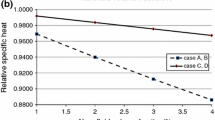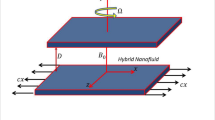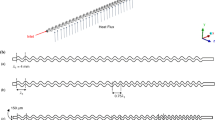Abstract
In this paper, the field synergy principle is firstly performed on the viscoelastic fluid-based nanofluid and other relevant fluid in channel at turbulent flow state to scrutinize their heat transfer performance based on our direct numerical simulation database. The cosine values of intersection angle between velocity vector and temperature gradient vector are calculated for different simulated cases with varying nanoparticle volume fraction, nanoparticle diameter, Reynolds number and Weissenberg number. It is found that the filed synergy effect is enhanced when the nanoparticle volume fraction is increased, nanoparticle diameter is decreased and Weissenberg number is decreased, i.e. the heat transfer is also enhanced. However, the filed synergy effect is weakened with the increase of Reynolds number which may be the possible reason for the power function relationship in empirical correlation of heat transfer between heat transfer performance and Reynolds number with the constant power exponent lower than 1. Finally, it is also observed that the field synergy principle can be used to analyze the heat transfer process of viscoelastic fluid-based nanofluid at the turbulent flow state even if some negative cosine values of intersection angle exist in the flow field.
Similar content being viewed by others
References
Bergles A E. Techniques to enhance heat transfer. In: Rohsenow W M, Hartnett J P, Chi Y I, eds. Handbook of Heat Transfer. 3rd ed. New York: McGraw-Hill, 1998. 11.1–11.76
Gao X M, Li W Y, Wang J S. Heat transfer and flow characteristics in a channel with one corrugated wall. Sci China Tech Sci, 2014; 57: 2177–2189
Guo Z Y, Li D Y, Wang B X. A novel concept for convective heat transfer enhancement. Int J Heat Mass Transfer, 1998; 41: 2221–2225
Tao W Q, He Y L, Wang Q W, et al. A unified analysis on enhancing single phase convective heat transfer with field synergy principle. Int J Heat Mass Transfer, 2002; 45: 4871–4879
Tao W Q, Guo Z Y, Wang B X. Field synergy principle for enhancing convective heat transfer–its extension and numerical verifications. Int J Heat Mass Transfer, 2002; 45: 3849–3856
Zeng M, Tao W Q. Numerical verification of the field synergy principle for turbulent flow. J Enhanced Heat Transfer, 2004; 11: 451–457
Wu L B, Li Z, Song Y Z. Field synergy principle of heat and mass transfer. Chin Sci Bull, 2009; 54: 4604–4609
Chen Q, Ren J, Meng J. Field synergy equation for turbulent heat transfer and its application. Int J Heat Mass Transfer, 2007; 50: 5334–5339
Liu W, Liu Z C, Ma L. Application of a multi-field synergy principle in the performance evaluation of convective heat transfer enhancement in a tube. Chin Sci Bull, 2012; 57: 1600–1607
Guo J, Xu M, Cheng L. The application of field synergy number in shell-and-tube heat exchanger optimization design. App energy, 2009; 86: 2079–2087
Guo Z Y, Tao W Q, Shah R K. The field synergy (coordination) principle and its applications in enhancing single phase convective heat transfer. Int J Heat Mass Transfer, 2005; 48: 1797–1807
Yan P G, Shi L, Wang X F, et al. Retrofit design of composite cooling structure of a turbine blade by fluid networks and conjugate heat transfer methods. Sci China Tech Sci, 2013; 56: 3104–3114
Hao J H, Chen Q, Xu Y C, et al. Flow field optimization and design for a Spallation Neutron Source target cooling system. Sci China Tech Sci, 2013; 56: 1370–1376
Choi S U S, Zhang Z G, Yu W, et al. Anomalous thermal conductivity enhancement in nanotube suspensions. Appl Phys Lett, 2001; 79: 2252–2254
Özerinç S, Kakaç S, Yazicioglu A G. Enhanced thermal conductivity of nanofluids: A state-of-the-art review. Microfluid Nanofluid, 2010; 8: 145–170
Kleinstreuer C, Feng Y. Experimental and theoretical studies of nanofluid thermal conductivity enhancement: A review. Nanoscale Res Lett, 2011; 6: 1–13
Xuan Y M, Li Q. Investigation on convective heat transfer and flow features of nanofluids. J Heat Transfer. 2003; 125: 151–155
Li Q, Xuan Y M. Convective heat transfer and flow characteristics of Cu–water nanofluid, Sci Chin E 2002; 45: 408–416
Ding Y, Alias H, Wen D, et al. Heat transfer of aqueous suspensions of carbon nanotubes (CNT nanofluids). Int J Heat Mass Transfer 2006; 49: 240–250
Özerinça S, Yazicioglua A G, Kakaç S. Numerical analysis of laminar forced convection with temperature-dependent thermal conductivity of nanofluids and thermal dispersion. Int J Therm Sci, 2012; 62: 138–148
Mokmeli A, Saffar-Avval M. Prediction of nanofluid convective heat transfer using the dispersion model. Int J Therm Sci, 2010; 49: 471–478
Sajadi A R, Kazemi M H. Investigation of turbulent convective heat transfer and pressure drop of TiO2/water nanofluid in circular tube. Int Comm Heat Mass Transfer, 2011; 38: 1474–1478
Wen D, Lin G, Vafaei S, et al. Review of nanofluids for heat transfer applications. Particuology, 2009; 7: 141–150
Zhang P G, Liang J D, Yin L Y, et al. The synthesis of micro-sized silicon carbide whiskers and the application for heat transfer enhancement. Sci China Tech Sci, 2014; 57: 2371–2378
Xuan Y, Li Q. Heat transfer enhancement of nanofluids. Int J Heat Fluid Flow, 2000; 21: 58–64
Ding Y, Wen D. Particle migration in a flow of nanoparticle suspensions. Powder Technol, 2005; 149: 84–92
Wen D, Ding Y. Effect of particle migration on heat transfer in suspensions of nanoparticles flowing through minichannels. Microfluidics Nanofluidics, 2005; 1: 183–189
Wen D, Ding Y. Experimental investigation into convective heat transfer of nanofluids at the entrance region under laminar flow conditions. Int J Heat Mass Transfer, 2004; 47: 5181–5188
Ting T W, Hung Y M, Guo N. Field-synergy analysis of viscous dissipative nanofluid flow in microchannels. Int J Heat Mass Transfer, 2014; 73: 483–491
Bhattacharya P, Samanta A.N, Chakraborty S. Numerical study of conjugate heat transfer in rectangular microchannel heat sink with Al2O3/H2O nanofluid. Heat Mass Transfer, 2009; 45: 1323–1333
Abbassi H, Aghanajafi C. Evaluation of heat transfer augmentation in a nanofluid-cooled microchannel heat sink. J Fusion Energy, 2006; 25: 187–196
Sajadi A R, Kazemi M H. Investigation of turbulent convective heat transfer and pressure drop of TiO2/water nanofluid in circular tube. Int Comm Heat Mass Transfer, 2011; 38: 1474–1478
Syam S L, Naik M T, Sharma K V, et al. Experimental investigation of forced convection heat transfer and friction factor in a tube with Fe3O4 magnetic nanofluid. Exp Thermal Fluid Sci, 2012; 37: 65–71
Yang J C, Li F C, Zhou W W, et al. Experimental investigation on the thermal conductivity and shear viscosity of viscoelastic-fluidbased nanofluids. Int J Heat Mass Transfer, 2012; 55: 3160–3166
Yang J C, Li F C, Zhou W W, et al. Experimental study on the characteristics of heat transfer and flow resistance in turbulent pipe flows of viscoelastic-fluid-based Cu nanofluid. Int J Heat Mass Transfer, 2013; 62: 303–313
Yang J C, Li F C, Cai W H, et al. On the mechanism of convective heat transfer enhancement in a turbulent flow of nanofluid investigated by DNS and analyses of POD and FSP. Int J Heat Mass Transfer, 2014; 78: 277–288
Li F C, Yang J C, Zhou W W, et al. Experimental study on the characteristics of thermal conductivity and shear viscosity of viscoelastic- fluid-based nanofluids containing multiwalled carbon nanotubes. Thermochim Acta, 2013; 556: 47–53
Yang J C, Li F C, Xu H P, et al. Heat transfer performance of viscoelastic fluid based nanofluid pipe flow at entrance region. Exp Heat Transfer, 2015; 28: 125–138
Yang J C, Li F C, Cai W H, et al. Direct numerical simulation of viscoelastic-fluid-based nanofluid turbulent channel flow with heat transfer. Chin Phys B, 2015, (in press)
Yu B, Kawaguchi Y. Direct numerical simulation of the viscoelastic drag-reducing Flow: A faithful finite-difference method. J Non- Newtonian Fluid Mech, 2004, 116: 431–466
Yu B, Kawaguchi Y. DNS of fully developed turbulent heat transfer of a viscoelastic drag-reducing flow. Int J Heat Mass Transfer, 2005; 48: 4569–4578
Li F C, Yu B, Wei J J, et al. Turbulent drag reduction by surfactant additives. John Wiley & Sons (Asia) Pet Ltd., March 2012
Author information
Authors and Affiliations
Corresponding author
Rights and permissions
About this article
Cite this article
Yang, J., Li, F., Ni, M. et al. Analysis of heat transfer performance for turbulent viscoelastic fluid-based nanofluid using field synergy principle. Sci. China Technol. Sci. 58, 1137–1145 (2015). https://doi.org/10.1007/s11431-015-5836-x
Received:
Accepted:
Published:
Issue Date:
DOI: https://doi.org/10.1007/s11431-015-5836-x




